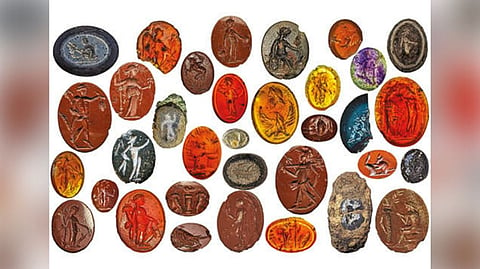

Franz Lidz
Down the drain is where British archaeologists recently discovered 36 artfully engraved semiprecious stones, in an ancient bathhouse at the site of a Roman fort near Hadrian’s Wall in Carlisle, England. The colorful intaglios — gems with incised carvings — likely fell out of signet rings worn by wealthy third-century bathers, and ended up trapped in the stone drains.
The delicate intaglios, fashioned from amethyst, jasper and carnelian, range in diameter from 5 millimetres to 16 millimetres — bigger than a pencil eraser, smaller than a dime. Some bear images of Apollo, Mars, Bonus Eventus and other Roman deities symbolizing war or good fortune. Others showcase Ceres, the god of fertility, Sol (the sun) and Mercury (commerce). One amethyst depicts Venus holding either a flower or a mirror. A reddish-brown jasper features a satyr seated on rocks beside a pillar. How and why these stones were lost is a subject of some debate among classicists. After six years of archaeological detective work that has provided a tantalising glimpse of Roman Britain, Frank Giecco, the technical director of the Carlisle project, believes that he and his team have solved the mystery.
Historically, two kinds of engraved gems were worn mounted on finger rings: intaglios, which have designs cut as a depression into the surface of the gem; and cameos, with designs that project from the background, a raised image in relief.
The tradition of intaglios goes back to the Sumerian period in Mesopotamia, where figures were gouged by hand into softer stone. From about 3,400 B.C., stamp seals and cylinder seals were pressed and imprinted into damp clay. These became popular in Minoan and Mycenaean Greece, Persia, Egypt and Rome, where they became objects of fashion; the statesman Cicero observed that people wore portraits of their favorite philosophers on their rings, a tradition that has not survived on today’s QVC Network.
The excavation at the Carlisle Cricket Club began in 2017 and quickly revealed a bathhouse that “was truly colossal in scale,” Giecco said. The bathhouse was built along the river Eden and near the Roman fort of Uxelodunum, also known as Petriana, which was safely situated behind Hadrian’s Wall, the empire’s northern border. Hadrian, the Roman emperor, ordered the wall built in 122 A.D. to ward off Caledonian tribes. At Uxelodunum — today a thriving suburb — were stationed the Ala Petriana, a large and elite cavalry regiment. A major civilian settlement — eventually Luguvalium, or Roman Carlisle — grew up to the immediate south.
The main building of the bathhouse, constructed around 210 A.D., had sandstone walls three-and-a-half feet thick. The baths were rebuilt in the fourth century and were still in use in the fifth; some parts were subsequently rebuilt in timber and may still have been standing in the 12th century, when the site was quarried for building materials. The region remained strategic. “We have found evidence of the 1645 and 1745 sieges of Carlisle during the English Civil War and Jacobite Rebellion,” Giecco said. In the early 20th century the site was turned into tennis courts.
Franz Lidz is a journalist with NYT© 2023
The New York Times
Visit news.dtnext.in to explore our interactive epaper!
Download the DT Next app for more exciting features!
Click here for iOS
Click here for Android